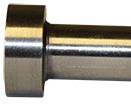Quickly Getting to the Root of the Problem
Diagnostic device helps molders simply check hot runner cables to ensure connectivity.
How much time do your maintenance personnel spend tracing wiring issues or identifying faulty heaters and thermocouples? Are they frustrated with old-school methods and the time it takes to identify the problem? How many hours do they waste checking a mold for issues only to find that a faulty cable is to blame?
Clack Corp.’s Rogers, Arizona, injection molding facility encountered this issue many times and found a solution in the CableXChecker cable testing system, distributed by Milacron’s DME Co. brand.
“Before, the best way to test a cable (either thermocouple or power) was to hold the cable between your legs and touch a multimeter to each contact point/pin,” says Michael McCutcheon, product manager for DME Industrial Supplies. “This required 576 point-to-point contacts to diagnose a 24-pin cable. Then, once the cable was repaired, this process had to be repeated to confirm the repair was completed correctly.”
The CableXChecker, manufactured for DME by Fast Heat Inc., enables maintenance personnel to cycle through a 24-pin cable in less than one minute, he says. “This will allow them to quickly rule out cable issues by confirming positive connection between the controller and mold on all zones quickly and safely.”
Gary Ash, Clack’s maintenance supervisor, confirms that the device speeds the diagnostic process. “In the real world, a mold setup person sets the mold, plugs in the hot runner and turns it on. Then, when a zone is not heating, what is the first thing you do? Where do you start? Do you start checking at the mold for shorted or open heaters, the cable, or the controller?”
With the CableXChecker, he simply plugs it in and turns the selector switch from zone to zone, and it tests the continuity of the entire cable. It can also identify shorted cables. “I can check thermocouple cables and power cables in just a minute or two, and I can eliminate or prove cable or plug failure in a couple of minutes instead of the 30 to 45 minutes it takes to get out a meter, jumper cables and alligator clips, and painfully check, pin for pin, each end of the plug,” he says. “Six times out of 10, the failure may not present itself until the cable is jiggled or moved.”
According to McCutcheon, the device was developed to help molders simply and quickly ensure connectivity in all zones and identify pushed-in pins, damaged pin crimps and unseated sockets. “This is done by using the same connectors your controller and mold use,” he says.
He says the device greatly reduces the possibility of human error, because it so simple to operate. The technician connects cables, one at a time, to each side of the CableXChecker, then he turns the dial through each zone, as corresponding lights confirm each circuit. If at any point an LED fails to light up, a short has occurred in that zone. If multiple LEDs illuminate, a short between those wires/zones has occurred. If an LED for a different zone lights up, the cable was wired incorrectly.
Easing the Process of Elimination
McCutchen says the tool ideally should be used to check cables before they are installed on the mold in order to prevent production downtime.
“The CableXChecker provides one step to quickly test the cables, then you can move onto the mold. It also allows you to test and verify your cables before setting up the process,” Ash confirms. “Or, if you suspect a bad cable and you go to get a spare, you can check the spare before you put it on. If we had a problem with a zone prior to having the CableXChecker, we had to get another cable and try it first without knowing if that cable was good.”
At the end of the day, Ash says use of the device cuts downtime dramatically “by the simple fact that it relieves one of the steps of the elimination process.” He also confirms that the device is simple to use, which means any one of the mechanics in his shop can use it effectively. “I no longer need the most skilled electrician in the shop checking cables,” he says.
Related Content
Questions and Considerations Before Sending Your Mold Out for Service
Communication is essential for proper polishing, hot runner manifold cleaning, mold repair, laser engraving and laser welding services.
Read MoreThe Ins and Outs of Hot Runner Temperature Control
A training checklist that explains the why and how of proper hot runner temperature control and system management.
Read MoreHow to Use Scientific Maintenance for More Accurate Mold and Part Troubleshooting
Discover how adopting scientific maintenance approaches helps improve mold lifespan, minimize failures, and optimize production outcomes.
Read MoreWhat is Scientific Maintenance? Part 2
Part two of this three-part series explains specific data that toolrooms must collect, analyze and use to truly advance to a scientific maintenance culture where you can measure real data and drive decisions.
Read MoreRead Next
For Better Mold Venting, Start with the Metal
Selecting the right material for specific mold components can help prevent a number of costly issues.
Read MoreReasons to Use Fiber Lasers for Mold Cleaning
Fiber lasers offer a simplicity, speed, control and portability, minimizing mold cleaning risks.
Read MoreHow to Use Continuing Education to Remain Competitive in Moldmaking
Continued training helps moldmakers make tooling decisions and properly use the latest cutting tool to efficiently machine high-quality molds.
Read More





















